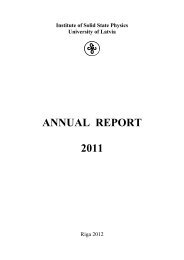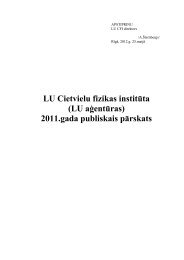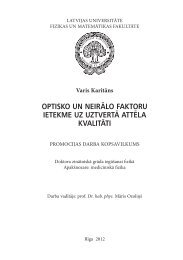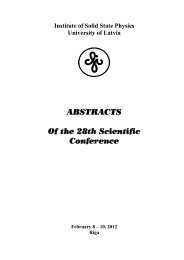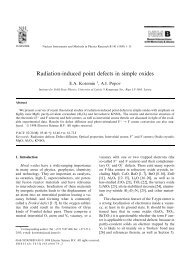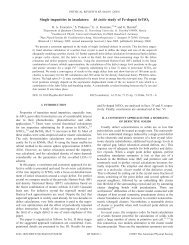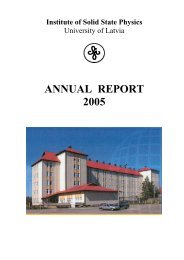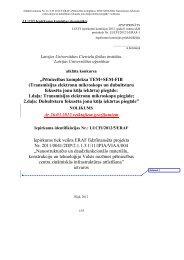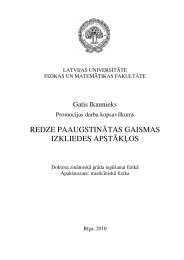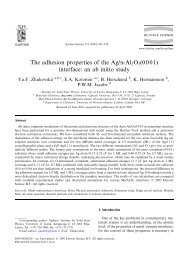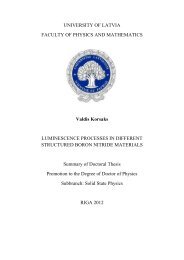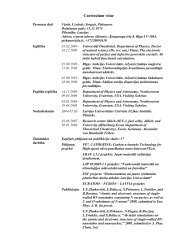Annual Report 2012 - Latvijas Universitātes Cietvielu fizikas institūts
Annual Report 2012 - Latvijas Universitātes Cietvielu fizikas institūts
Annual Report 2012 - Latvijas Universitātes Cietvielu fizikas institūts
Create successful ePaper yourself
Turn your PDF publications into a flip-book with our unique Google optimized e-Paper software.
Main Results<br />
SUBWAVELENGTH STRUCTURES IN AMORPHOUS CHALCOGENIDE<br />
THIN FILMS<br />
Mara Reinfelde and Janis Teteris<br />
Thin films of amorphous chalcogenide semiconductor As 2 S 3 , As-Se and As-S-Se<br />
systems were used for recording of refractive index and surface-relief modulated<br />
gratings. Amorphous chalcogenide semiconductors are high index materials with<br />
refractive index in the range 2.2 – 3.5, depending on the film composition and light<br />
wavelength. The photoinduced changes of refractive index down to Δn≈0.15 – 0.5 are<br />
observed in these systems.<br />
The photo- and electron-beam stimulated changes of wet etching rate in<br />
amorphous As-S, As-Se and As-S-Se films have been studied. Amorphous chalcogenide<br />
semiconductor (AChS) resists obtained by thermal deposition in vacuum are<br />
characterized by very high resolution capability and they possess a number of<br />
peculiarities that make them attractive for application in many photo- and electron-beam<br />
lithographic (EBL) processes.<br />
The recording of the subwavelength gratings with a period of 0.15 μm – 1 μm<br />
was performed by holographic method. The fringe period for two intersecting light<br />
beams in a media with high refractive index n can be expressed as Λ=λ 0 /2 n sinθ, where<br />
λ 0 is the wavelength of laser light in vacuum, n is refractive index of the resist and θ is<br />
the half-angle between the laser beams inside the resist. The right angle prisms with n=<br />
1.8 – 2.6 were used to increase the value of θ. The grating period and profile after<br />
chemical etching was measured by AFM. The transmission, reflection and polarization<br />
properties of the obtained gratings were studied.<br />
OPTICAL RECORDING IN AMORPHOUS CHALCOGENIDE THIN FILMS<br />
Janis Teteris<br />
During the past 10 years, research in the field of optical materials based on<br />
amorphous chalcogenide semiconductors has made significant advances. Much of this<br />
research is driven by applied interest and this field of research is extremely broad and<br />
active. The use of amorphous chalcogenide thin films in holography and lithography has<br />
probably only just begun, but already produced some promising results.<br />
The main functional principles and practical application of amorphous<br />
chalcogenide photoresists for production of the embossed rainbow holograms and<br />
holographic optical elements are discused. The laser interference lithography is used as a<br />
low-cost method for the exposure of large surfaces with regular patterns like<br />
subwavelength-gratings and microsieves. The regular features with the sizes of about 50<br />
nm and less can be fabricated by this method. The Bragg reflection gratings were<br />
recorded and studied in amorphous As 2 S 3 and As-S-Se films. Amorphous chalcogenide<br />
thin films are thought to be one of the potential materials for all-optical integrated<br />
circuits for the optical communication systems due to their excellent infrared<br />
transparency, large nonlinear refractive index, and low phonon energies. The possibility<br />
to use the amorphous chalcogenide films as a media for holographic recording,<br />
processing and storage of information with high density is discussed.<br />
100



